Siamese cat
The Siamese cat is one of the first distinctly recognized breeds of Asian cat. Derived from the Wichianmat landrace, one of several varieties of cat native to Thailand (formerly known as Siam), the original Siamese became one of the most popular breeds in Europe and North America in the 19th century. The carefully refined, more extreme-featured, modern-style Siamese is characterized by blue almond-shaped eyes; a triangular head shape; large ears; an elongated, slender, and muscular body; and various forms of point colouration. Other than colouration, the modern-style Siamese bears little resemblance to the original stock, and the more moderate, traditional, or "old-style" Siamese, with a much rounder head and body, has been re-established by multiple registries as the Thai cat. The International Cat Association describes the modern Siamese as affectionate, social, intelligent, and playful into adulthood, often enjoying a game of fetch.[1] Siamese tend to seek human interaction and also like companionship from other cats.
| Siamese Cat | |
|---|---|
 Lilac-point Siamese (Oriental) | |
| Common nicknames | Meezer, Mese |
| Origin | Thailand |
| Breed standards | |
| TICA | standard |
| ACF | standard |
| ACFA/CAA | standard |
| CCA-AFC | standard |
| Domestic cat (Felis catus) | |
The Siamese (sometimes in the traditional form) is among the foundation stock of several other breeds developed by crossbreeding with other cats; some examples are the Oriental Shorthair and Colourpoint Shorthair, developed to expand the range of coat patterns; the long-haired variant most often dubbed the Himalayan; and hair-mutation breeds, including the Cornish Rex, Sphynx, Peterbald, and blue-point Siamese cat. The Siamese cat comes in two distinct variations: traditional, with an apple-shaped head and a slightly chubby body; or the modern Siamese, which are very skinny and have a wedge-shaped head. The long-haired Siamese is recognized internationally as a Balinese cat. Siamese cats are one of the more common breeds to have different colored irises.
History
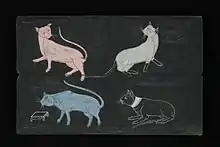
Thailand
A description and depiction of the Wichienmaat (Siamese cat) first appears in a collection of ancient manuscripts called the Tamra Maew (The Cat-Book Poems), thought to originate from the Ayutthaya Kingdom (1351 to 1767 AD). Over a dozen are now kept in the National Library of Thailand, while others have resurfaced outside of Thailand and are now in the British Library and National Library of Australia. In addition to the old Siamese cat, the Tamra Maew also describes other heritage cats of Thailand including the Korat cat (Malet), which are still bred for preservation in Thailand today and have become popular in other countries, and Konja cat (Black cat), Suphalak (a controversy in Burmese cat).
When the capital city Ayutthaya was sacked on 7 April 1767 at the end of the Burmese-Siamese war, the Burmese army burned everything in sight and returned to Burma, taking Siamese noblemen and royal family members with them as captives. Buddha images were hacked apart for their gold, and all the royal treasures were stolen. Thai legend has it that the King of Burma Hsinbyushin found and read the poem for the Thai cats in the Tamra Maew. The poem describes Thai cats as being as rare as gold, and anyone that owns this cat will become wealthy. He told his army to round up all the Suphalak cats and bring them back to Burma along with the other treasures. Today in Thailand, this legend is told as a humorous explanation as to the rarity of Thai cats.
Siamese
The pointed cat known in the West as "Siamese", recognized for its distinctive markings, is one of several breeds of cats from Siam described and illustrated in manuscripts called "Tamra Maew" (Cat Poems), estimated to have been written from the 14th to the 18th century.[2] In 1878, U.S. President Rutherford B. Hayes received the first documented Siamese to reach the United States, a cat named "Siam" sent by the American Consul in Bangkok.[3] In 1884, the British Consul-General in Bangkok, Edward Blencowe Gould (1847–1916),[4] brought a breeding pair of the cats, Pho and Mia, back to Britain as a gift for his sister, Lilian Jane Gould (who, married in 1895 as Lilian Jane Veley,[5] went on to co-found the Siamese Cat Club in 1901). In 1885, Gould's UK cats Pho and Mia produced three Siamese kittens—Duen Ngai, Kalohom, and Khromata—who were shown with their parents that same year at London's Crystal Palace Show. Their unique appearance and distinct behaviour attracted attention but all three of the kittens died soon after the show, their cause of death not documented.[6]
By 1886, another pair (with kittens) was imported to the UK by Eva Forestier Walker (surnamed Vyvyan after 1887 marriage)[7] and her sister, Ada. Compared to the British Shorthair and Persian cats that were familiar to most Britons, these Siamese imports were longer and less "cobby" in body types, had heads that were less rounded with wedge-shaped muzzles and had larger ears. These differences and the pointed coat pattern, which had not been seen before in cats by Westerners, produced a strong impression—one early viewer described them as "an unnatural nightmare of a cat." Over the next several years, fanciers imported a small number of cats, which together formed the base breeding pool for the entire breed in Britain. It is believed that most Siamese in Britain today are descended from about eleven of these original imports. In their early days in Britain, they were called the "Royal Cat of Siam", reflecting reports that they had previously been kept only by Siamese royalty.[8] Later research has not shown evidence of any organised royal breeding programme in Siam.[2] The original Siamese imports were medium-sized, rather long-bodied, muscular, graceful cats with moderately wedge-shaped heads and ears that were comparatively large but in proportion to the size of the head. The cats ranged from substantial to slender but were not extreme in either way.
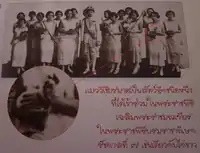 King Prajadhipok following his coronation day, surrounded by the court ladies carrying his regalia and what is today regarded as a Thai cat, the cat symbolises 'domesticity'.
King Prajadhipok following his coronation day, surrounded by the court ladies carrying his regalia and what is today regarded as a Thai cat, the cat symbolises 'domesticity'. Wankee, born 1895 in Hong Kong, became the first UK Siamese champion in 1898.
Wankee, born 1895 in Hong Kong, became the first UK Siamese champion in 1898. While this show quality specimen from 1960 still exhibits relatively moderate characteristics, the breed standard was setting the stage for the modern Siamese, with its call for a "dainty, long and svelte" body, a long head that "taper[s] in straight lines from the ears to a narrow muzzle", "ears large and pricked, wide at the base" and tail "long and tapering".
While this show quality specimen from 1960 still exhibits relatively moderate characteristics, the breed standard was setting the stage for the modern Siamese, with its call for a "dainty, long and svelte" body, a long head that "taper[s] in straight lines from the ears to a narrow muzzle", "ears large and pricked, wide at the base" and tail "long and tapering".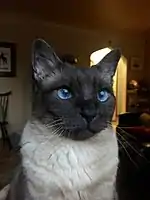 Seal point Siamese-Himalayan hybrid
Seal point Siamese-Himalayan hybrid
Traditional Siamese versus modern development
In the 1950s–1960s, as the Siamese was increasing in popularity, many breeders and cat show judges began to favor the more slender look. As a result of generations of selective breeding, they created increasingly long, fine-boned, narrow-headed cats. Eventually, the modern show Siamese was bred to be extremely elongated, with a lean, tubular body, long, slender legs, a very long, very thin tail that tapers gradually into a point and a long, wedge-shaped head topped by extremely large, wide-set ears.
By the mid-1980s, cats of the original style had largely disappeared from cat shows but a few breeders, particularly in the UK, continued to breed and register them, resulting in today's two types of Siamese: the modern, "show-style", standardized Siamese, and the "Traditional Siamese", both descended from the same distant ancestors, but with few or no recent ancestors in common, and effectively forming distinct sub-breeds, with some pressure to separate them entirely.
In addition to the modern Siamese breed category, The International Cat Association (TICA) and the World Cat Federation (WCF) now accept Siamese cats of the less extreme type, and any wichianmat cat imported directly from Thailand, under the new breed name Thai.[9][10] Other, mostly unofficial, names for the traditional variety are "Old-style Siamese", "Classic Siamese", and "Applehead" (originally a derogatory nickname coined by breeders of modern-type Siamese).[11]
Appearance
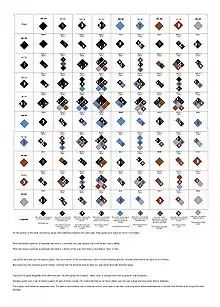
The breed standard of the modern Siamese calls for an elongated, tubular, and muscular body and a triangular head, forming a perfect triangle from the tip of the nose to each tip of the ear. The eyes are almond-shaped and light blue, while the ears are large, wide-based, and positioned more towards the side of the head. The breed has a long neck, a slender tail, and fur that is short, glossy, fine, and adheres to the body with no undercoat. Its pointed color scheme and blue eyes distinguish it from the closely related Oriental Shorthair. The modern Siamese shares the pointed color pattern with the Thai, or traditional Siamese, but they differ in head and body type.
The pointed pattern is a form of partial albinism, resulting from a mutation in tyrosinase, an enzyme involved in melanin production. The mutated tyrosinase enzyme is heat-sensitive; it fails to work at normal body temperatures, but becomes active in cooler (< 33 °C) areas of the skin.[12] This results in dark colouration in the coolest parts of the cat's body, including the extremities and the face, which is cooled by the passage of air through the sinuses. All Siamese kittens, although pure cream or white at birth, develop visible points in the first few months of life in colder parts of their body.[13] By the time a kitten is four weeks old, the points should be sufficiently clearly distinguishable to recognise which colour they are. Siamese cats tend to darken with age, and generally, adult Siamese living in warm climates have lighter coats than those in cool climates. Originally the vast majority of Siamese had seal (extremely dark brown, almost black) points, but occasionally Siamese were born with "blue" (a cool grey) points, genetically a dilution of seal point; chocolate (lighter brown) points, a genetic variation of seal point; or lilac (pale warm gray) points, genetically a diluted chocolate. These colours were at first considered "inferior" seal points, and were not qualified for showing or breeding. All of these shades were eventually accepted by the breed associations, and became more common through breeding programmes specifically aimed at producing these colours. Later, outcrosses with other breeds developed Siamese-mix cats with points in other cat colours and patterns, including Red and Cream point, lynx (tabby) point, and tortoise-shell ("tortie") point.
In the United Kingdom, all pointed Siamese-style cats are considered part of the Siamese breed. In the United States, a major cat registry, the Cat Fanciers' Association, considers only the four original fur colors as Siamese: seal point, blue point, chocolate point, and lilac point. Oriental Shorthair cats with color points in colors or patterns aside from these four are considered color point Shorthairs in that registry. The World Cat Federation has also adopted this classification, treating the color point Short hair as a distinct breed.[10]
Many Siamese cats from Thailand had a kink in their tails, but over the years this trait has been considered a flaw. Breeders have largely eradicated it, but the kinked tail persists among street cats in Thailand.
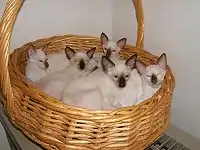 Seal point Siamese kittens
Seal point Siamese kittens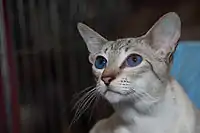 Seal tabby silver Siamese
Seal tabby silver Siamese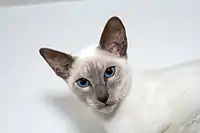 Lilac point Siamese cat
Lilac point Siamese cat Side view of the head of a chocolate point adult
Side view of the head of a chocolate point adult
Temperament
Siamese are usually very affectionate and intelligent cats, renowned for their social nature. Many enjoy being with people and are sometimes described as "extroverts". Often they bond strongly to a single person. Some Siamese are extremely vocal, with a loud, low-pitched voice—known as "Meezer", from which they get one of their nicknames[6]—that has been compared to the cries of a human baby, and persistent in demanding attention. These cats are typically active and playful, even as adults, and are often described as more dog-like in behavior than other cats.[14][15]
Siamese cats, due to their desire to be near people or other cats, occasionally suffer from depression or separation anxiety if left alone for long periods of time, and it is for this reason that Siamese cats are often bought in pairs so that they can keep each other company.[16]
Health
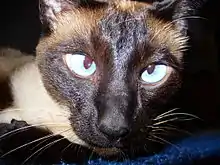
Based on Swedish insurance data, which tracked cats only up to 12.5 years, Siamese and Siamese-derived breeds have a higher mortality rate compared to other breeds. The median lifespan of the Siamese group was somewhere between 10 and 12.5 years; 68% lived to 10 years or more and 42% to 12.5 years or more. Siamese Scooter holds the record as the world's oldest male cat, dying at the age of 30.[17] The majority of deaths were caused by neoplasms, mainly mammary tumors. The Siamese also has a higher rate of morbidity. They are at higher risk of neoplastic and gastrointestinal problems, but have a lower risk of feline lower urinary tract disease.[18][19] Vet clinic data from England shows a higher median lifespan of 14.2 years.[20]
The most common variety of progressive retinal atrophy (PRA) in cats (among them the Abyssinian, the Somali, and the big group of Siamese-related breeds) is related to a mutation on the rdAc-gene, for which a DNA test is available.[21]
The same albino allele that produces coloured points means that Siamese cats' blue eyes lack a tapetum lucidum, a structure which amplifies dim light in the eyes of other cats. The mutation in the tyrosinase also results in abnormal neurological connections between the eye and the brain.[22] The optic chiasm has abnormal uncrossed wiring; many early Siamese were cross-eyed to compensate, but like the kinked tails, the crossed eyes have been seen as a fault, and due to selective breeding the trait is far less common today. Still, this lack of a tapetum lucidum even in uncross-eyed cats causes reduced vision for the cat at night. This trait has led to their dependence and interest in humans, as it affects their hunting ability, a desirable trait for many owners. However, it also makes them vulnerable to urban dangers such as night-time vehicular traffic. Unlike many other blue-eyed white cats,[23] Siamese cats do not have reduced hearing ability.
Furthermore, the Siamese cat is more prone than other breeds to lung infections, especially in kittenhood, such as feline osteochondrodysplasia, vestibular disease and feline hyperesthesia syndrome.[24]
Breeds derived from the Siamese
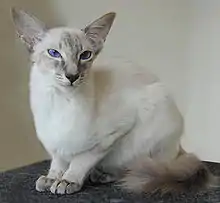
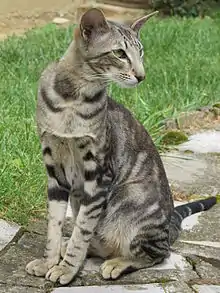
- Balinese – Natural mutation of the Siamese cat; a longhaired Siamese. In the largest US registry, the Cat Fanciers Association (CFA), limited to the four traditional Siamese coat colors of seal point, blue point (a dilute of seal point), chocolate point, and lilac point (a dilute of chocolate point). Other registries in the US and worldwide recognise a greater diversity of colours.
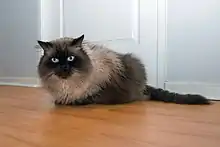 Himalayan Cat, breed derived from crosses of Persians to Siamese
Himalayan Cat, breed derived from crosses of Persians to Siamese - Bengal cat – This interspecific hybrid cat breed was created by breeding an Asian leopard cat and a Siamese cat together.
- Birman – After almost all the individuals of the breed died out during the years of World War II, French breeders reconstructed the breed through interbreeding with various other breeds, including the Siamese. Modern Birman cats have inherited their pointed coat patterns from the Siamese.
- Burmese is a breed of domesticated cats descended from a specific cat, Wong Mau, who was found in Burma in 1930 by Joseph Cheesman Thompson. She was brought to San Francisco, where she was bred with Siamese. While technically not derived from Siamese, the breed was considered a form of Siamese for many years, leading to crossbreeding.
- Havana Brown resulted from crossing a chocolate-point Siamese with a black cat.
- Colorpoint Shorthair – a Siamese-type cat registered in CFA with pointed coat colours aside from the traditional CFA Siamese coat colours; originally developed by crosses with other shorthair cats. Considered part of the Siamese breed in most cat associations, but considered a separate breed in CFA and WCF. Variations can include lynx points and tortie points.
- Himalayan – Longhaired breed originally derived from crosses of Persians to Siamese and pointed domestic longhair cats to introduce the point markings and the colours chocolate and lilac. After these initial crosses were used to introduce the colours, further breed development was performed by crossing these cats only to the Persian breed. In Europe, they are referred to as colourpoint Persians. In CFA, they are a colour division of the Persian breed.
- Javanese – in CFA, a longhaired version of the Colourpoint Shorthair (i.e. a "Colourpoint Longhair"). In WCF, however, "Javanese" is an alias of the Oriental Longhair.
- Ocicat – a spotted cat originally produced by a cross between Siamese and Abyssinian.
- Oriental Shorthair – a Siamese-style cat in non-pointed coat patterns and colours, including solid, tabby, silver/smoke, and tortoise-shell.
- Oriental Longhair – a longhaired version of the Oriental Shorthair.
- Savannah – The Savannah is a domestic hybrid cat breed. It is a hybridization between a serval and a domestic cat. (The first was bred with a Siamese)
- Snowshoe – a cream and white breed with blue eyes and some points that was produced through the cross-breeding of the Siamese and bi-coloured American Shorthair in the 1960s.
- Thai Cat – also called the Wichian Mat or Old Style Siamese, the original type of Siamese imported from Thailand in the 19th century and still bred in Thailand today; and throughout the first half of the 20th century, the only type of Siamese.[25]
- Tonkinese – originally a cross between a Siamese cat and a Burmese. Tonkinese × Tonkinese matings can produce kittens with Burmese sepia pattern, Siamese pointed pattern, or a Tonkinese mink pattern (which is something in between the first two, with less pattern contrast than the Siamese but greater than the Burmese); often with aqua eyes.
- Mekong Bobtail (Thai Bobtail)
In media
In literature and film
Siamese cats have been protaganists in literature and film for adults and children since the 1930's. Clare Turlay Newberry's Babette[26] features a Siamese kitten escaping from a New York apartment in 1937. British publisher Michael Joseph recorded his relationship with his Siamese cat in Charles: The Story of a Friendship (1943).[27] The "Siamese Cat Song" sequence ("We are Siamese if you please") in Disney's Lady and the Tramp (1955), featuring "Si" and "Am", became "notorious for its racist depiction of the Siamese cats".[28] The 1958 film adaptation of Bell, Book and Candle features Kim Novak's own Siamese cat as "Pyewacket", a witch's familiar. The Incredible Journey (1961)[29] by Sheila Burnford tells the story of three pets, including Siamese cat "Tao", as they travel 300 miles (480 km) through the Canadian wilderness searching for their beloved masters. The book was a modest success when first published, but became widely known after 1963 when it was loosely adapted into a film of the same name from Walt Disney. Disney also employed the same Siamese in the role of "DC" for its 1965 crime caper That Darn Cat!,[30] with The New York Times commenting "The feline that plays the informant, as the F.B.I. puts it, is superb. [...] This elegant, blue-eyed creature is a paragon of suavity and grace".[31]
Other
- In The Wizard of Oz a Siamese Cat is the cause for Dorothy's missing the balloon ride back to Kansas. As the balloon is just about to lift off with the Wizard, Dorothy and Toto on board, a girl in the crowd is holding a Siamese Cat which distracts Toto, causing him to jump out of the basket which, of course, causes Dorothy to jump out in pursuit.
- Bob Dylan mentioned a Siamese cat in his 1965 song "Like a Rolling Stone".
- The original Hang in there, Baby poster by Victor Baldwin featured a Siamese kitten named Sassy.
- The Rolling Stones song "Under My Thumb" includes the lyric "Under my thumb, a Siamese cat of a girl."
- Three Siamese cats are the main characters of the children's book Sagwa, the Chinese Siamese Cat by Amy Tan and the animated TV series of the same name.
- In the comic strip Get Fuzzy, one of the main protagonists is a Siamese cat named Bucky Katt.
- In The Cat Who... novel series by author Lilian Jackson Braun, a reporter and his Siamese cats, Koko and Yum Yum, solve mysteries together.
- In Krypto the Superdog Catwoman's cat, Isis, is a Siamese cat and a villain.
- In The Aristocats, Shun Gon is a Siamese with a Chinese accent and a member in Scat Cat's gang.
- A Siamese cat named Kenny appears in the Flying Witch anime. He is the familiar of Akane.
- In the Bad Kitty book series, there is a talkative Siamese cat named 'Chatty Kitty'. Nearly every time she meows, there is a star next to her meowing, which translates it.
- A Siamese cat is featured on the cover art for the Blink-182 album Cheshire Cat.
- In Garfield: The Movie, Nermal, a friend/rival of Garfield, is a Siamese cat.
- In the Skippyjon Jones book series, the titular character is a Siamese cat who befriends a group of Chihuahuas.
- The first Blue Peter pet cat, Jason, was a Seal-point Siamese Cat.
- My Favorite Murder podcast host Georgia Hardstark owns a cross-eyed Siamese Cat named Elvis. Each episode after saying their catchphrase "Stay Sexy and Don't Get Murdered", Hardstark asks "Elvis, want a cookie?" and the episode is ended by Elvis meowing into the microphone. He has garnered much attention from the fandom due to his prominent meow and crossed eyes, and often acts as a mascot for the show.
- Meowth, one of the most popular Pokemon is based on a Siamese Cat.
See also
- Thai cat, a.k.a. Old-style Siamese or Traditional Siamese
References
- "SIAMESE". The International Cat Association.
- Clutterbuck, Martin R. (2004). Siamese Cats: Legends and Reality. Bangkok: White Lotus. ISBN 978-974-480-053-4.
- "Siam: America's First Siamese Cat". Archived from the original on 5 May 2009. Retrieved 13 February 2009.
- "Edward Blencowe Gould or Owen Gould". Archived from the original on 11 March 2005. Retrieved 14 August 2006.
- General Register Office Register of Marriages SEP 1895 5b 217 NEWTON A. Victor Herbert Veley = Lilian Jane Gould
- Connor, Janine (2007). I am Siamese - How to raise Siamese cats and kittens. ISBN 978-0-9804291-0-7.
- General Register Office Register of Marriages MAR 1887 1a 19 PADDINGTON Courtney Bouchier Vyvyan = Eva Catherine F. Walker
- Weir, Harrison (1889). Our Cats. London. ISBN 978-1-84664-097-1.
- The International Cat Association. "Thai Breed Standard" (PDF). Archived from the original (PDF) on 7 April 2009. Retrieved 9 September 2009.
- "Recognized and Admitted Breeds in the WCF". WCF-Online.de. 2016. Retrieved 4 April 2016.
- Bird, Cris. "The Types of Siamese". Archived from the original on 30 September 2006. Retrieved 27 September 2006.
- D. L. Imes; et al. (April 2006). "Albinism in the domestic cat (Felis catus) is associated with a tyrosinase (TYR) mutation". Animal Genetics. 37 (2): 175–8. doi:10.1111/j.1365-2052.2005.01409.x. PMC 1464423. PMID 16573534.
- Ye X.C.; Pegado V.; Patel M.S.; Wasserman W.W. Strabismus (2014). "genetics across a spectrum of eye misalignment disorders". Clinical Genetics. 86 (2): 103–11. doi:10.1111/cge.12367. PMC 4233980. PMID 24579652.
- "Breed Portrait of the Siamese Cat" (PDF). Cat Fanciers Federation. Archived from the original (PDF) on 10 August 2006. Retrieved 10 August 2006.
- Myrna M. Milani, D.V.M. (1987). The Body Language and Emotion of Cats. New York: Quill. ISBN 978-0-688-12840-1.
- "Siamese Cats UK". 8 August 2013. Archived from the original on 8 August 2013.
- "Oldest cat in the world, Scooter, dies aged 30". BBC. 14 May 2016. Retrieved 16 May 2016.
- Egenvall, A.; Nødtvedt, A.; Häggström, J.; Ström Holst, B.; Möller, L.; Bonnett, B. N. (2009). "Mortality of Life-Insured Swedish Cats during 1999—2006: Age, Breed, Sex, and Diagnosis". Journal of Veterinary Internal Medicine. 23 (6): 1175–1183. doi:10.1111/j.1939-1676.2009.0396.x. PMC 7167180. PMID 19780926.
- Egenvall, A.; Bonnett, B. N.; Häggström, J.; Ström Holst, B.; Möller, L.; Nødtvedt, A. (2010). "Morbidity of insured Swedish cats during 1999–2006 by age, breed, sex, and diagnosis". Journal of Feline Medicine & Surgery. 12 (12): 948–959. doi:10.1016/j.jfms.2010.08.008. PMID 21055987.
- O'Neill, D. G. (2014). "Longevity and mortality of cats attending primary care veterinary practices in England" (PDF). Journal of Feline Medicine and Surgery. 17 (2): 125–33. doi:10.1177/1098612X14536176. PMID 24925771. "n=31, median=14.2, IQR 10.8–19.0, range 0.9–21.1"
- "DNA testing for PRA". PawPeds. Retrieved 12 January 2012.
- Jon H, Kaas (2005). "Serendipity and the Siamese cat: The discovery that genes for coat and eye pigment affect the brain". ILAR Journal. 46 (4): 357–363. doi:10.1093/ilar.46.4.357. PMID 16179744.
- "Congenital Deafness and Its Recognition". Veterinary Clinics of North America: Small Animal Practice. Retrieved 15 January 2015.
- "Siamese Cat Health Issues". www.sweetiekitty.com. 7 March 2017. Retrieved 10 March 2017.
- Amy Rebeka. "Thai Cat History". Archived from the original on 16 October 2007. Retrieved 29 May 2007.
- New York: Harper & Brothers.
- London: Michael Joseph Ltd.
- Lady and the Tramp: Siamese cat characters to be scrapped from Disney remake
- London: Hodder & Stoughton
- Wilson, Staci Layne (2007). Animal Movies Guide. Running Free Press. p. 16. ISBN 9780967518534.
- New York Times: That Darn Cat. 3 December 1965.
External links
| Wikimedia Commons has media related to Siamese cats. |
| Look up Siamese cat in Wiktionary, the free dictionary. |